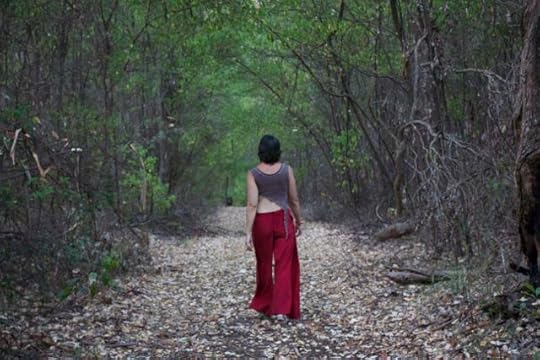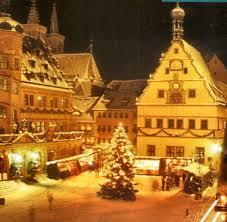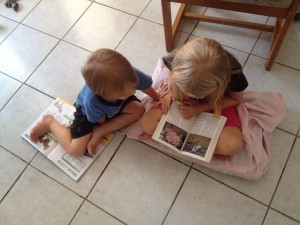Rolf Potts's Blog, page 50
December 24, 2013
5 More things I’m learning from life and travel
Vagablogging :: Rolf Potts Vagabonding Blog
Last week I shared five things that life and travel are teaching me.
This week, I’d like to share five more…
1. To figure it out
There is nothing like having everything go to perdition on a far off continent when you don’t speak the language. In epic ways: like the stock market crashing and taking all of our money with it, and small ways: like having to get a delirious kid to a hospital, pronto, traveling teaches us to figure it out. When there’s no friend to call for help, no safety net in place, and no option to pass the buck, I have to figure it out. What I’ve learned: I can be trusted to figure it out. That’s a good thing to know about myself.
2. To have faith
Faith in the traditional, religious sense, hasn’t worked out too well for me over the long haul; it’s a long story, but suffice to say I’m best defined as a skeptic. When I say I’m learning to have faith, I mean in juxtaposition to fear. To have faith in my own ability rather than to wonder if I can pull it off. To have faith in my fellow man, rather than fear his intention. To have faith in humanity to move forward for the collective good. To have faith that there is, indeed, light at the end of many a long tunnel. When I live my life from a point of faith instead of a point of fear, everything becomes possible.
3. To dream big
Perhaps, to some people, an open ended world tour with their family is a big dream. It was for us, once. It was the big dream that we sacrificed everything else for, and it’s been infinitely worth it. But now, it’s our “inside the box.” Long term travel isn’t hard. No where on the planet is out of reach. If anything, the problem is that we have so many options that it’s hard to choose which adventure to have next. We are learning to dream bigger, to open the next box and crawl out. The view from the tipping point of the lid is spectacular, clear to the horizon. That’s the cool thing about cultivating and achieving your dreams, one at a time; you realize that the really big, really epic thing that you worked flat out for, reached clear to the edge of your current horizon to grab hold of… is actually just the next wrung of the ladder, and there’s another rung, almost out of reach, waiting to be grabbed. One dream leads to another. I just have to keep climbing.
4. Be generous
I’ve never understood the impulse to hoard stuff, money, time, people, or anything else. I was raised in a family of givers, and to me, it’s just “the way we live.” Travel has just deepened those lessons and reinforced my natal belief that we are here to share and to give. I love to give. Stuff is just stuff, we share it where we can. Money is just money, if we have it, we give it. Time is the real gift, the true treasure in life, and when we have the opportunity to give time, that is the most precious form of sharing of all. The thing I’m learning from travel is how to receive as generously as we strive to give. The great blessing of being taken into a stranger’s home, life, kitchen, and heart. The generous friendship that results when we allow ourselves to be taken care of. The opportunities that then present themselves to reciprocate. I’m fortunate to live among, and call my friends, some of the most generous people on the planet. It’s great fun to strive to out-do one another in giving, sharing, loving and meeting each other’s needs. One of the best parts of our long term travel has been the many opportunities we’ve been presented with to give generously, and the many times we’ve been gifted with more than we could ever imagine.
5. Keep walking
Life is hard, isn’t it? Work is hard. Parenting is hard. Sometimes marriage is hard. Keeping all the plates spinning is hard. Travel is hard. Staying home is hard. Struggle seems common to man. My Dad has been known to say that, “Time carries us away from all things.” The older I get, the more I wade through, the more I realize the truth of his words and the layers of meaning below them. I thought I knew what they meant at 18; I did not. I hope I know now, but I suspect there is more to learn. The only trick I know for getting through the hard is a lesson learned every day we travel: just keep walking. Through the literal, the figurative, and the metaphorical, the emotional and the physical hardships. Just keep walking. Moving forward is the only answer. I can’t go back. Get over that thought right now. To stop is to start sinking, to mire in my own mental state. Drowning isn’t an appealing thought. So I must move forward. Of course I walk a lot, in the physical sense, it’s my own form of therapy, but really, the important walking is internal, and it’s there that I’m learning to keep pressing forward, to insist on proactive measures and growth towards productive ends.
What is your journey teaching you?
Original article can be found here: 5 More things I’m learning from life and travel
December 23, 2013
Tamales and Coffee
Vagablogging :: Rolf Potts Vagabonding Blog
I spent some time talking with local residents of Monteverde, asking about the history and traditions associated with their Christmas holiday celebrations. Everyone got so excited that they started talking over one another, but I had a translator, so I think we captured everything they wanted to share with me. Here is some unique insight on Costa Rican traditions, and more specifically, traditions of Monteverde.
Festival de la Luz is a holiday festival held in San Jose every year. The people of Monteverde view the big city as a bit intimidating, especially with young children, so seven years ago, they adapted their own version of Festival de la Luz, naming it Monteverde Brilla, translated as “Monteverde Shines”. On the first Thursday of December, the community celebrates culture, art, and healthy recreation for the whole family, with a parade made up of bands, floats, and performing groups. They hope every year to teach their children the history of Costa Rica, and form healthy traditions among children, families, and the local community. I heard school bands practicing everywhere I walked last month, as they prepared to play during this festival, and it is something Monte Verde is very proud of.
Costa Ricans have adopted a lot of American traditions, such as giving gifts to children from “Santa Claus,” and singing Christmas carols. But because this area is largely influenced by Quakers, who first settled in Monteverde during the Korean War, there are alternative traditions offered as well. The Monteverde Friends School recently built a new meeting hall where they hosted a beautiful holiday presentation by the children who attend the school. This meeting hall doubles as a place of silent worship. Quakers in the community hold a special yearly service where the whole community gathers, shares food, and trades cookies, after singing traditional carols.
Some Quakers and others in the community keep Jesus’ birth at the forefront of the holiday and teach children that Jesus wasn’t given gifts until days later when the Wise Men brought him Frankincense and myrrh. For this reason, some people do not give gifts to children until a week or two after Christmas.
At the beginning of December, families decorate Christmas trees and put out their nativity scenes. They do not place Jesus in the scene until Christmas Eve at midnight.
Families gather on December 22 and 23 to make tamales, which is a long-lasting tradition for them. During Christmas, they include various types and cuts of meat, rice, and vegetables. Tamales are also popular during Holy Week at the end of April, but meat is traditionally not included. In December, families cook and trade tamales, while drinking Rompope (their version of egg nog WITH alcohol).
At midnight on Christmas Eve, when families introduce baby Jesus into the nativity scene, they each eat a grape (I am told that some families eat a total of only 12 grapes, while others don’t have a particular number), and make a wish for the new year and the new season. They hug, and celebrate good things they are expecting in the coming season.
On Christmas Day, families gather with neighbors and friends, share food, drinks, songs, and gifts. I was told to look forward to eating tamales while drinking fresh coffee with them on Christmas Day. Tamales and coffee? I honestly cannot wait.
A Monteverde family’s nativity scene before Jesus arrives
Original article can be found here: Tamales and Coffee
December 22, 2013
Mark Salzman on the easy cliches of travel writing
Vagablogging :: Rolf Potts Vagabonding Blog
“One strike against travel writing, though, is that many writers who describe familiar places without making shallow or trite observations suddenly run into trouble when they go on the road. They seem to lose their inhibitions when they find themselves in exotic surroundings, and start telling us how red-cheeked and healthy the children look, how much more in touch with nature Third World farmers appear, or how dull-witted the natives look because they stare at foreigners with their mouths hanging open. Part of the fun of being a traveler is making broad generalizations from what little you see and hear, or discovering that there is a grain of truth in many cultural stereotypes, but those sorts of insights don’t necessarily belong in a book.”
–Mark Salzman, in They Went: The Art and Craft of Travel Writing (1991)
(1991)
Original article can be found here: Mark Salzman on the easy cliches of travel writing
December 19, 2013
Christmas in France–delicious and traditional
Vagablogging :: Rolf Potts Vagabonding Blog
One of the great things about Europe is its magnificent Christmases, when the frosty air is infused with a spirit of joy and celebration. From Scotland to Slovakia, a smorgasbord of culture is on display as each country celebrates with its own unique traditions.
This is the second in a series about the Continent’s various subtle (and sometimes not-so-subtle) yuletide differences that make each culture uniquely fun.
Some of France’s yuletide traditions have spilled over to the US, where we associate the word “Noel” with the holiday. In fact Noel is the French word for Christmas, stemming from the French phrase les bonnes nouvelles, which means “the good news”.

Christmas in Alsace.
Paris, the City of Light, celebrates in a less red-and green-light gaudy way than big US cities. But don’t let that fool you into thinking it’s a realm of secular Scrooges: its neighborhoods often host popular Christmas markets that are as festive as any scene in New York City. The shoppers bustle under the glow of the light-strewn Eiffel Tower, radiating light like a beacon against the cold night sky.
In the countryside, where the culture of any people really resides and thrives, the traditions are stronger and richer. The warm tones of local choirs singing medieval carols can be heard emanating from candle-lit, thirteenth-century churches. Soaring abbeys host more elaborate performances of ancient music under their arches. The smell of burning wood emanates from the fireplaces and stoves of old farmhouses in the chiller Normandy and Brittany regions, while the southern areas of the country enjoy the more moderate temperatures afforded by their proximity to the Mediterranean. Epic manger scenes crowd around the courtyards in front of the great cathedrals, uncomfortably close to the commerce-heavy outdoor markets where locals score the freshest chestnuts and tastiest red wine while shivering carolers entertain with the old favorites.
In this strongly Catholic country, many families will attend the midnight Mass and return home to enjoy le réveillon, or the “wake-up!” meal.
And that meal is fantastic. Being France, the food is an integral part of the celebration—in fact it’s the culinary high point of the year for many. Delicacies like foie gras, oysters and escargots are popular aperitifs, while the entrée tends to be more straight-forward dishes like goose (popular in Alsace) and turkey (more popular in Burgundy).
Meat (including ham and duck) is paired with a good red wine and served with the ever-popular chestnut stuffing, a French favorite for generations. Chubby truffles are another beloved feature of most dinners. While the use of the actual Yule log has diminished somewhat, the French make a traditional Yule log-shaped cake called the buche de Noel. It’s a sugary delight of chocolate and chestnuts.
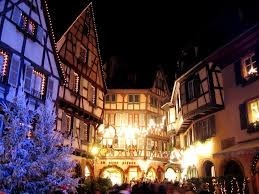
Small towns do Christmas right.
After the Mass and le réveillon, the children put their shoes in front of the fireplace hoping that Pere Noel (Father Christmas) will fill them with candy, nuts, fruit and gifts. As the kids drift off to sleep, the adults sit up late, hang goodies from the tree and polish off the Yule log. Before they turn in for the night, a softly burning candle is are left on the table in case the Virgin Mary passes by, a long-standing custom of this Catholic country.
From Bayeux to Arles, France revels in its ancient cultural traditions as it celebrates the Noel with that classically French combination of style and joy. Gift giving is less emphasized than the act of gathering and celebrating simple rituals with family and friends—and sharing a fine meal with good wine, of course.
Original article can be found here: Christmas in France–delicious and traditional
December 17, 2013
5 Things I’m learning from life and travel
Vagablogging :: Rolf Potts Vagabonding Blog
It is raining this morning, and I am sick.
It’s one of those mornings where I long for a bathtub and a big fluffy bed and endless documentary television to while away a day when I’m too icky to do anything else. Instead, I’m tucked up in my little cave bed with my second cup of tea, listening to raindrops and resting. It’s almost as good! 
Instead of hiking the coast of the Coromandel Peninsula and digging out big pools of thermal water on a hot water beach this afternoon, we’re tucked in under a solid rain, making the best of our camper life. I was awake most of the night (did I mention that I’m sick!?) thinking about the things that travel is teaching me. Care to take a midnight wander through my brain?
1. Flexibility
Travel is yoga for the soul. By nature I’m a planner and an organizer and a low-level control freak. The road is doing its best to bend that out of me, one country, one culture, one mini-catastrophe at a time. I no longer expect anything to run on schedule. If well made plans for a day crash and burn, well, there must be something else more important for the day. Mealtimes are flexible. Bedtimes are flexible. The definition of “food and lodging” are flexible. There really isn’t much in life that can’t be flexible, if I’m willing to bend with the wind and go with the flow… which, incidentally, is the key to reducing stress and increasing joy in the journey.
2. What I do not need
I have more than I need. I have always had more than I’ve needed, without exception. I do not “need” most of what I have, and knowing that has increased my gratefulness for the small things and the many comforts. I don’t have a bathtub, a big fluffy bed, or a TV this morning. But my little camper bed, my cup of tea and my cheese plate are still more than I need and I’m so glad for all three! Realizing what I don’t need has increased contentment and lowered my expectations and pretty much removed the anxiety that surrounds collecting “stuff” to pad our existence.
3. This is my life
A camper van cab top bed, my hubby’s knit hat on my sick noggin, a cheese plate and a cup of tea. This is my life. My life is no more than the moment I’m in. Where I’ve been doesn’t matter as much as where I’m going. Where I’m going doesn’t matter as much as where I am. There’s nothing to be gained from comparison to anyone or anything else. I am where I am because of the choices I’ve made. If I don’t like it, I can change it. All I have is today, this moment, sick in the rain. What will I make of it?
4. Who I am
I suppose all of life, from cradle to grave is an exercise in peeling back the layers of the onion, defining and redefining this, for all of us. The growing and changing and continual evolution of self is something interesting to me to watch, from somewhere outside of myself. Of course it’s a horrible cliche, that travel introduces you to yourself, but it’s true. Getting outside of all of the preconceived constructs that define a person is educational indeed. When there are no walls, no fences, no comfy confines, what will I do? Who am I really? How do I meet the world? Where do I fit in it? What can I give? These are the questions that define us, and redefine us. The questions that have brought me to my knees in places, both geographically and internally.
5. To Make my own box
The idea that we can get “outside the box” in this life is just silly. Just about the time you climb out of the box you think you’re in, you climb into another one. We have people say to us, regularly, “Wow!! You guys live such an “outside the box” life…” And I get what they mean. Yes, we do in some ways: no house, nomadic, alternatively educated kids, careers outside of the cube wars. But we live a very “inside the box” life in the world we exist in: there are tons of other families what we call friends who live just like we do. We’re nothing special. They aren’t impressed. We’re in the box for them. So, at the end of the day, the thing I’m learning is that it isn’t about escaping from some mythical box, it’s about creating your own, according to your own passions, and your own definition of normal. My life is delightfully “in the box,” I’ve just created it myself and plastered the sides with travel posters!
What is life and travel teaching you?
Original article can be found here: 5 Things I’m learning from life and travel
December 15, 2013
All experience is an arch wherethro’ gleams that untravel’d world
Vagablogging :: Rolf Potts Vagabonding Blog
“I cannot rest from travel: I will drink
Life to the lees: All times I have enjoy’d
Greatly, have suffer’d greatly, both with those
That loved me, and alone, on shore, and when
Thro’ scudding drifts the rainy Hyades
Vext the dim sea: I am become a name;
For always roaming with a hungry heart
Much have I seen and known; cities of men
And manners, climates, councils, governments,
Myself not least, but honour’d of them all;
And drunk delight of battle with my peers,
Far on the ringing plains of windy Troy.
I am a part of all that I have met;
Yet all experience is an arch wherethro’
Gleams that untravel’d world, whose margin fades
Forever and forever when I move.
How dull it is to pause, to make an end,
To rust unburnish’d, not to shine in use!
As tho’ to breathe were life. Life piled on life
Were all too little, and of one to me
Little remains: but every hour is saved
From that eternal silence, something more,
A bringer of new things; and vile it were
For some three suns to store and hoard myself,
And this gray spirit yearning in desire
To follow knowledge like a sinking star,
Beyond the utmost bound of human thought.”
–Alfred Tennyson, “Ulysses” (1833)
Original article can be found here: All experience is an arch wherethro’ gleams that untravel’d world
December 11, 2013
Vagabonding Field Report: Giant Kite Festival – Sumpango, Guatemala
Vagablogging :: Rolf Potts Vagabonding Blog

Cost/day: $40/day
What’s the strangest thing you’ve seen lately?
GIGANTIC kites made from tissue paper, tape and bamboo. Incredible and beautiful!
 Describe a typical day:
Describe a typical day:
Awoke this morning at The Homestead, ready for our trip to explore Guatemala before heading south to El Salvador. First stop? The Giant Kite Festival in Sumpango, in celebration of Dia de los Muertos. The atmosphere at the event was similar to that of a fair or carnival, with food stands and kite flying competitions, but the most incredible part was gawking with head bent upward toward the sky at the colossal, colorful kites.
Describe an interesting conversation you had with a local:
There were people from all nationalities and backgrounds in attendance at the festival… many Guatemalans, but also European, American and Australian tourists. Unfortunately, the only talking I did was to order food or ask for a bathroom… other than that I was gazing and taking photos.
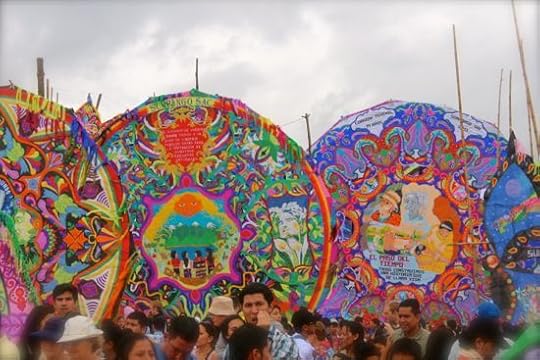
What do you like about where you are? Dislike?
I absolutely loved seeing the beautiful kites. They were works of art, and must have taken hours and hours to complete. What a labor of devotion and appreciation for a holiday that honors one’s ancestors. I disliked seeing them almost destroyed by the wind, after all the work that went into them. I wonder what they do with them after the event?
Describe a challenge you faced:
Our biggest challenge today was trying to decide which delicious food to eat. Ohh, and we did get stopped as we tried to leave town, by dancers in the street.
What new lesson did you learn?
I learned greater appreciation for the artistic abilities of the Guatemalan people. In the past, I haven’t necessarily considered this culture as being ‘artistic’, but the kites were truly masterpieces.
Where next?
Next we’ll be headed to Antigua, Guatemala… one of my favorite Guatemalan cities!
See more photos and video of the Kite Festival, or connect with me on Facebook.
Original article can be found here: Vagabonding Field Report: Giant Kite Festival – Sumpango, Guatemala
December 10, 2013
Christmas magic in Germany
Vagablogging :: Rolf Potts Vagabonding Blog
One of the many great things about Europe is the magnificent way it celebrates the Christmas season. Throughout the continent, a spirit of festivity can be felt in the wintertime air. The traditions of the season are still strong in this thoroughly modern part of the world, where bustling Christmas markets fill the main square of big cities and bucolic, half-timbered villages alike. In the cathedrals, choirs singing the great medieval Christmas hymns fill the cavernous spaces with angelic harmonies.
With that said, this is the first in a series of posts on the various ways Christmas is celebrated in Europe. While each country has its own festive quirks, many of them share the greatest of the ancient traditions and it’s a joy to be enveloped by it.
Germany, for example, is one of the most magical places to experience the season. This seems ironic, as it’s arguably Europe’s most progressive, twenty-first century nation. But old traditions die hard and Germany reaches far into its medieval past to embrace and celebrate the season. From the Austrian border to the Baltic Sea, from the Black Forrest to Berlin, Germany comes alive at the holidays. Its people break out the gingerbread recipes, the carols, and the colors of the season.
The sprawling Christkindle Markets fill the squares of communities across the country, bursting with music and food and seasonal décor. Traditional favorites such as gingerbread and sweet prune-and-fig candies are served at stalls under a kaleidoscope of Christmas colors. It’s not unusual for a small chorus to be serenading the bundled-up shoppers and sightseers with classic old Germanic carols, their puffs of visible breath ascending into the sky on the frosty air.
Performances of the Nutcracker are to be found in theatres across the country, while well-built manger scenes adorn the cobbled public spaces of both the predominantly Catholic South and Protestant North (this, after all the birthplace of Luther and Protestantism). Jolly St. Nicholas looms in the dreams of children eager for the big day to arrive.
It’s a good reminder that there is more to Germany that Oktoberfest and the Autobahn. They keep the best of their ancient traditions very much alive as they indulge in the classic sights, sounds and tastes of Christmas festivity.
Original article can be found here: Christmas magic in Germany
An international driving test: Can you pass?
Vagablogging :: Rolf Potts Vagabonding Blog
We’re taking this family adventure to the next level this winter. It’s the whole reason we’re making a pass back through North America, to tell the truth. We have two teenagers who need to procure driving licenses before we launch them into the world as fully viable adults. The easiest place for our bi-national kids to leap that hurdle is in the USA, where graduated licensing hasn’t quite caught on and the state motto of our official residence is “Live Free, or Die.” Indeed. This takes on new meaning when one’s spawn slides eagerly behind the wheel with a glint in his eye.
American kids go through a prescribed procedure, depending on their state, usually including formal lessons and a test, before they get their licenses. Canadian standards are similar, but more stringent. British kids learn to drive even though the poor things have to master doing it on the wrong side of the road. But what about international kids? What about those growing up across countries and continents; what sort of driving instruction should they have?
Tony and I have been considering this, as we prepare to launch our own young into the wheeled fray and we’d like to submit the following to the International Committee of Worldschooling Parents as a basic proficiency test for International Licensing:
1. Which side of the road should one drive on?
a- the right side
b- the left side
c- the top side
d- the side with fewest potholes & least oncoming traffic
e- there’s a side?
2. When driving on a 1.5 lane road the procedure for passing is as follows:
a- do not pass, you need two lanes to do that
b- blink lights twice, then pass on the left, hoping the overtaken will squeeze right
c- wait for an oncoming bus, hammer it to the floor and yell, “Banzai!”
d- pass on the berm to the right
e- play chicken with oncoming traffic in the half lane
3. When sharing the roadway with a passenger bus, two Bedouin on camels, a sleeping dog, three naked children, a flock of chickens and push-cart selling fried dough, who has the right of way?
a- the bus
b- the children
c- the pushcart
d- the dog
e- none of the above, there is a herd of goats crossing
4. A branch, or small bush laying in the roadway means that:
a- road crews are clearing the sides
b- something fell off of a truck
c- there is a truck broken down ahead
d- firewood is for sale ahead
e- a hurricane has just blown through
5. Which of the following does not belong on the highway:
a- livestock
b- lawn tractors
c- bicycles
d- drunk locals
e- you
6. How many passengers can you fit on a 3rd class bus:
a- capacity stated by the manufacturer
b- twice the capacity stated by the manufacturer
c- depends on their genus, phylum & species
d- is one of them carrying durian fruit?
e- one more
7. Should you help your father when he is pulled over by the police in Tunisia?
a- yes, he’s your dad
b- no, hang him out to dry
c- depends on whether or not he’s stopped speaking Spanish in a French-Arab country and making you translate yet
d- only if they make him get out of the car
e- my dad would never get pulled over by the police in Tunisia
8. When stopped by a policeman, in Oaxaca, wearing a badge that says, “I’m not corrupt, are you?” The correct course of action is:
a- pretend not to speak Spanish
b- offer him a bribe
c- hand him your passport and drivers license and act innocent
d- smile and negotiate the “fine” to a lower level
e- hand him your fake ID and drive off
9. The appropriate way to transport a pig is:
a- well, that depends on how far we’re going
b- in a registered farm vehicle
c- on his own three feet (he was lucky!)
d- in a basket on top of the bus
e- trussed out with bamboo, slung across the back of a moped
10. The maximum number of persons to be transported on a moped is:
a- two
b- Amsterdam, or Hanoi?
c- depends on how many kids you have
d- are we counting the sidecar?
e- locals or tourists?
11. When transporting a child under two on a moped the following is essential:
a- a helmet
b- a wicker chair for him to sit in
c- balance
d- a belief in Darwin’s theory of Natural Selection
e- an understanding of “Inshah Allah”
12. When presented with a grungy traveler hitchhiking one should:
a- pick him up
b- toss him a beer and keep rolling
c- assess his potential as a traveling companion based on number of instruments he carries
d- scratch and sniff
e- clap out the window
13. Which road sign should be taken most seriously:
a- stop sign
b- “turn left with caution”
c- camel crossing
d- green branch in the road
e- “toilet to puke in ahead”
14. When passing on a mountain curve:
a- wait for the cloud to lift
b- you don’t pass on a mountain curve, that’s dangerous
c- ambulance chase the chicken bus
d- honk and hope
e- are we going up, or down?
15. Rank in order, from safest to least safe:
a- Mexico City at rushour
b- six backpackers with gear in a Cambodian tuk-tuk in monsoon
c- crossing the street in Hanoi
d- bicycling in Rome
e- taking a cab in NYC
Post Script:
Dear Children (or others new to international driving)
Your performance on this test, both theoretical and physical will not only determine when and if you get to drive, but where and what. Above average results will earn you wheels from 2- 16 on dirt paths to the autobahn. Below average results will relegate you to diesel water buffalo and hitchhiking (better learn to play an instrument!)
With love,
Your International Parents
Original article can be found here: An international driving test: Can you pass?
December 9, 2013
5 Ways to Embrace Holiday Traditions While Traveling Abroad
Vagablogging :: Rolf Potts Vagabonding Blog
Holidays for me have always been about tradition, but I decided this year that I wanted to experience the holidays abroad, so my family and I are spending a few months in Monte Verde, Costa Rica. I thought it would be magical to be in the mountains for Christmas and celebrate the holidays Tico-style. But I’ll admit I was a little sad when I realized that we would would be skipping nearly all of our former traditions this year because a small strand of lights here is over $10 USD, which meant one strand was our only splurge, and because we accidentally left our “Elf on a Shelf” back home. But traveling fine-tunes my improvising skills, so we have created some new traditions this year.
1. Making nature ornaments.
There are very few Christmas ornaments in the markets here, and the ones that are available are about 5-6 times the price of the ones in the states. This year, we opted to make our own ornaments out of things we found on our nature walks. The kids picked flowers, found interesting leaves and fruits that had fallen along the road, and pressed beans and rice into no-bake ornaments we whipped up. We also strung a huge bag of Fruit Loops into garland, and drew pictures of mountains to hang up around the house. These are all special because so much of the flora here is unique, and we can keep our ornaments as memories of our first Christmas abroad. What types of ornaments or holiday decor can you create that is special to your current location?
2. Wrapping adventure coupons.
It’ funny, but I noticed recently that I have never seen a kid here playing outside with toys. I have only seen them playing with things they have made, playing tag, running, or climbing trees. It makes sense now that I know there very few toys available to buy in Monte Verde. The few I have seen in the grocery store are so incredibly over-priced that no one really buys them. This year, for Christmas, I opted out of buying junky plastic toys for the kids, and I am wrapping adventure coupons that they can redeem for a fun trip to the Arenal Volcano, where we will stay for 2 days and search for lava rocks! Shhh, it’s a surprise! I also found a cute little bookstore, where I’ll get a couple of books for them to enjoy on future bus and plane rides. What gifts do you give your children when you are away from home for the holidays?
3. Reading stories about Christmas celebrations all over the world.
My 5 year old doesn’t understand why none of the homes here are adorned with Christmas lights and why there are hardly any trees in the windows. She asks why things are so different here than back in Austin. The best way I have found to explain this is by finding stories about how other cultures celebrate different holidays or by showing her YouTube videos on celebrations in other countries. This gets her excited to try new traditions and embrace celebrating holidays the way local people do, instead of feeling like she is missing out on something from back home.What is a unique tradition you have introduced to your family, inspired by your travels?
4. Preparing traditional local dishes.
I’m not a huge fan of cooking (though I am a pro at chopping up a bunch of random ingredients and throwing them in a pot), but I do like the challenge of learning to prepare traditional (or typical) local dishes. We went to a Christmas party with Ticos over the weekend, and they prepared Costa Rican tamales, rice, and veggies, which was very different from any holiday meal I ever had back in the states. Now I’m teaching myself how to prepare them so I can serve them to my family on Christmas Day this year. Besides, it is impossible to find a ham or turkey up here! What “local” dishes have you prepared that stand out from your own traditions?
5. Giving back.
Not because it’s Christmas but because it’s the best way to say “thank you”. When we are miles away from home and routine, the community that we are a part of becomes extended family. They embrace us, welcome us, invite us into their homes and lives, introduce us to new traditions, and show us new perspectives. While traveling, we may not have a lot of extra money, but we do have time, and people value that much more anyway. Look into volunteer opportunities during your stay abroad this season. The kids and I are looking forward to spending time at a local school in Monte Verde this next semester. How do you show appreciation to a community while you are traveling?
Original article can be found here: 5 Ways to Embrace Holiday Traditions While Traveling Abroad
Rolf Potts's Blog
- Rolf Potts's profile
- 323 followers




